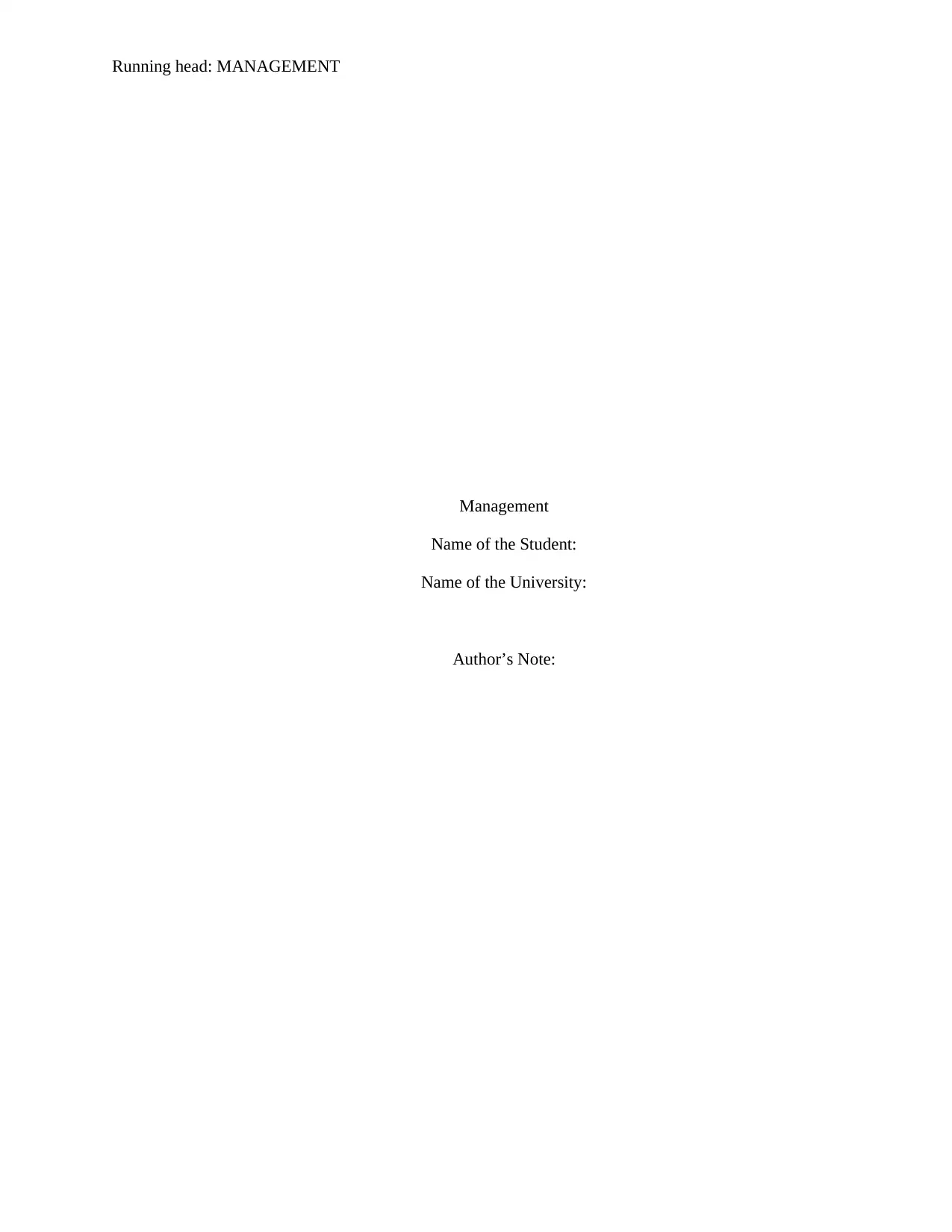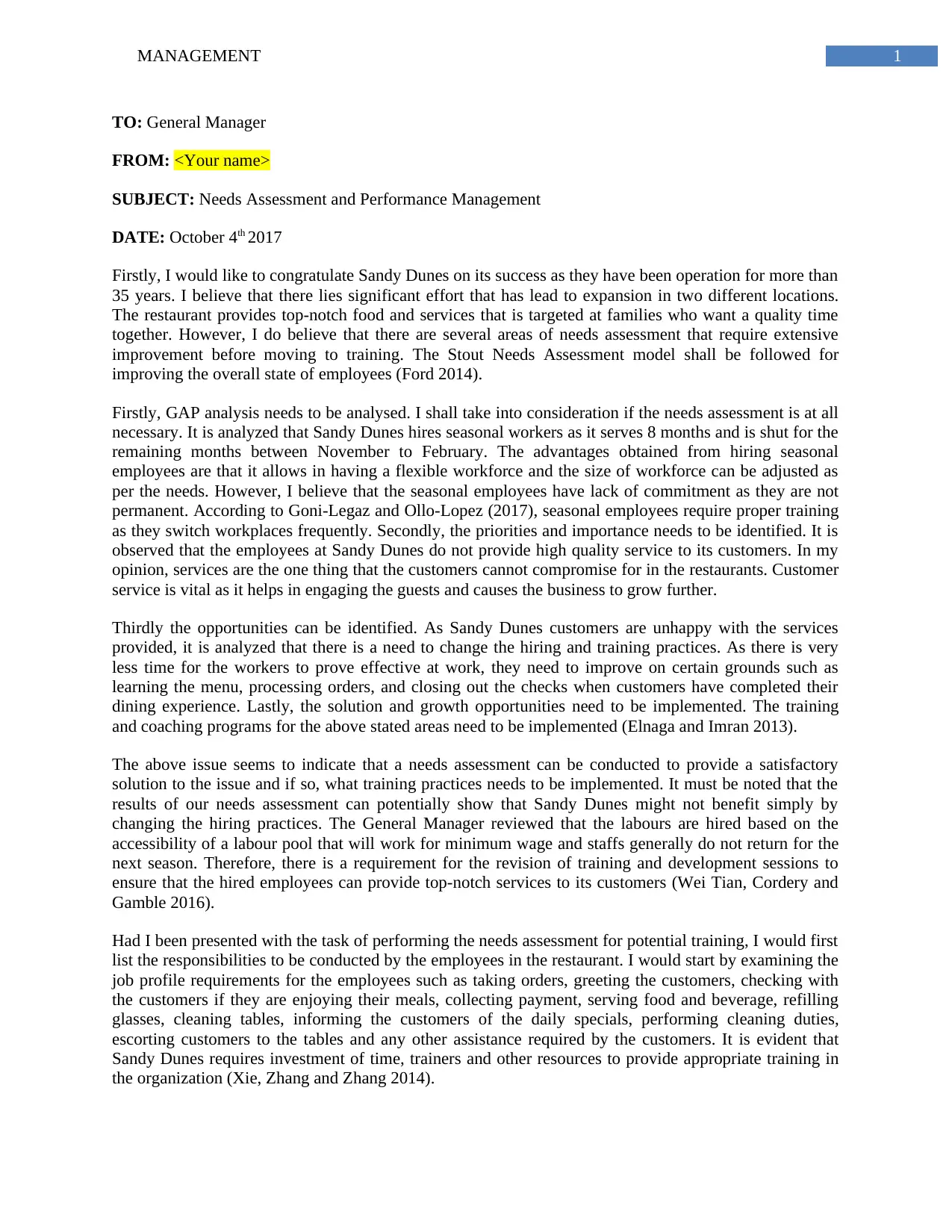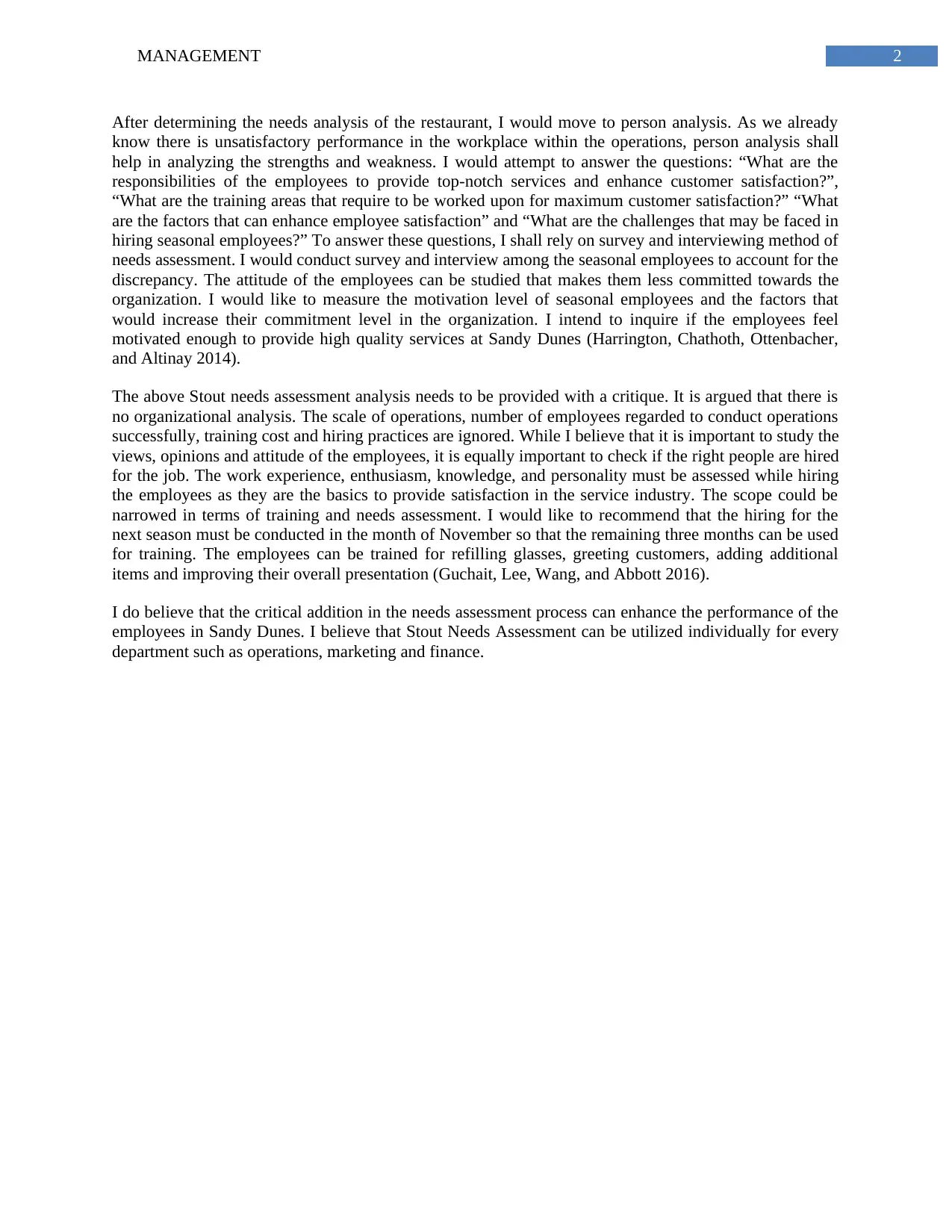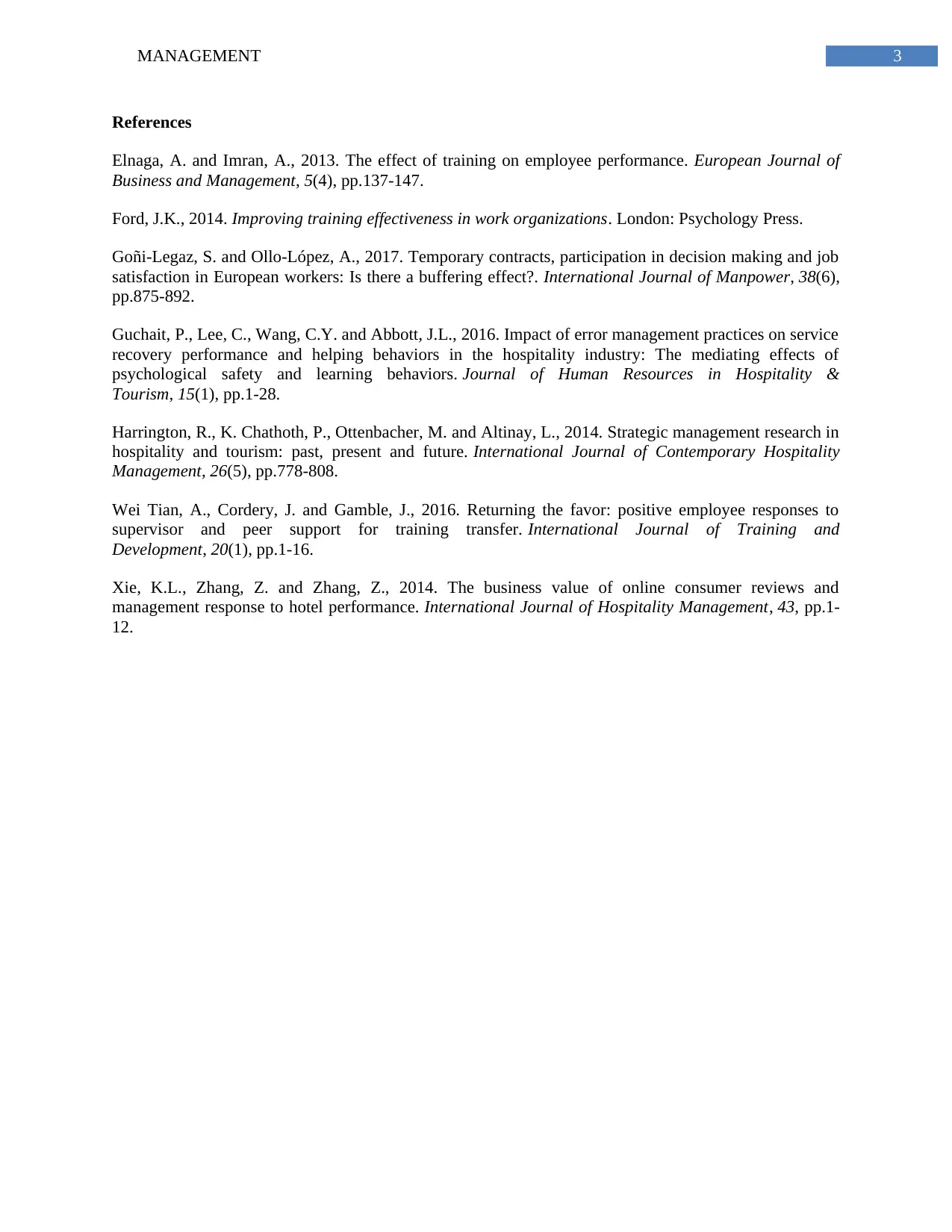Needs Assessment and Performance Management Report for Sandy Dunes
VerifiedAdded on 2020/03/16
|4
|1443
|43
Report
AI Summary
This report provides a needs assessment and performance management analysis for Sandy Dunes, a restaurant operating for over 35 years, facing challenges with its seasonal workforce. The report applies the Stout Needs Assessment model to identify gaps in employee performance and customer service. It examines the advantages and disadvantages of hiring seasonal employees, the importance of customer service, and opportunities for improvement in hiring and training practices. The report recommends a comprehensive training program focusing on job-specific skills and customer interaction. It emphasizes the need for organizational and person analysis, including surveys and interviews to understand employee motivation and commitment. The report critiques the assessment, highlighting the importance of considering organizational factors like training costs and hiring practices. It suggests improvements to the hiring process, proposing a longer training period before the peak season and recommends utilizing the Stout Needs Assessment model for each department within Sandy Dunes. The report concludes by highlighting the potential for enhanced employee performance through the implementation of the proposed recommendations.

Running head: MANAGEMENT
Management
Name of the Student:
Name of the University:
Author’s Note:
Management
Name of the Student:
Name of the University:
Author’s Note:
Paraphrase This Document
Need a fresh take? Get an instant paraphrase of this document with our AI Paraphraser

1MANAGEMENT
TO: General Manager
FROM: <Your name>
SUBJECT: Needs Assessment and Performance Management
DATE: October 4th 2017
Firstly, I would like to congratulate Sandy Dunes on its success as they have been operation for more than
35 years. I believe that there lies significant effort that has lead to expansion in two different locations.
The restaurant provides top-notch food and services that is targeted at families who want a quality time
together. However, I do believe that there are several areas of needs assessment that require extensive
improvement before moving to training. The Stout Needs Assessment model shall be followed for
improving the overall state of employees (Ford 2014).
Firstly, GAP analysis needs to be analysed. I shall take into consideration if the needs assessment is at all
necessary. It is analyzed that Sandy Dunes hires seasonal workers as it serves 8 months and is shut for the
remaining months between November to February. The advantages obtained from hiring seasonal
employees are that it allows in having a flexible workforce and the size of workforce can be adjusted as
per the needs. However, I believe that the seasonal employees have lack of commitment as they are not
permanent. According to Goni-Legaz and Ollo-Lopez (2017), seasonal employees require proper training
as they switch workplaces frequently. Secondly, the priorities and importance needs to be identified. It is
observed that the employees at Sandy Dunes do not provide high quality service to its customers. In my
opinion, services are the one thing that the customers cannot compromise for in the restaurants. Customer
service is vital as it helps in engaging the guests and causes the business to grow further.
Thirdly the opportunities can be identified. As Sandy Dunes customers are unhappy with the services
provided, it is analyzed that there is a need to change the hiring and training practices. As there is very
less time for the workers to prove effective at work, they need to improve on certain grounds such as
learning the menu, processing orders, and closing out the checks when customers have completed their
dining experience. Lastly, the solution and growth opportunities need to be implemented. The training
and coaching programs for the above stated areas need to be implemented (Elnaga and Imran 2013).
The above issue seems to indicate that a needs assessment can be conducted to provide a satisfactory
solution to the issue and if so, what training practices needs to be implemented. It must be noted that the
results of our needs assessment can potentially show that Sandy Dunes might not benefit simply by
changing the hiring practices. The General Manager reviewed that the labours are hired based on the
accessibility of a labour pool that will work for minimum wage and staffs generally do not return for the
next season. Therefore, there is a requirement for the revision of training and development sessions to
ensure that the hired employees can provide top-notch services to its customers (Wei Tian, Cordery and
Gamble 2016).
Had I been presented with the task of performing the needs assessment for potential training, I would first
list the responsibilities to be conducted by the employees in the restaurant. I would start by examining the
job profile requirements for the employees such as taking orders, greeting the customers, checking with
the customers if they are enjoying their meals, collecting payment, serving food and beverage, refilling
glasses, cleaning tables, informing the customers of the daily specials, performing cleaning duties,
escorting customers to the tables and any other assistance required by the customers. It is evident that
Sandy Dunes requires investment of time, trainers and other resources to provide appropriate training in
the organization (Xie, Zhang and Zhang 2014).
TO: General Manager
FROM: <Your name>
SUBJECT: Needs Assessment and Performance Management
DATE: October 4th 2017
Firstly, I would like to congratulate Sandy Dunes on its success as they have been operation for more than
35 years. I believe that there lies significant effort that has lead to expansion in two different locations.
The restaurant provides top-notch food and services that is targeted at families who want a quality time
together. However, I do believe that there are several areas of needs assessment that require extensive
improvement before moving to training. The Stout Needs Assessment model shall be followed for
improving the overall state of employees (Ford 2014).
Firstly, GAP analysis needs to be analysed. I shall take into consideration if the needs assessment is at all
necessary. It is analyzed that Sandy Dunes hires seasonal workers as it serves 8 months and is shut for the
remaining months between November to February. The advantages obtained from hiring seasonal
employees are that it allows in having a flexible workforce and the size of workforce can be adjusted as
per the needs. However, I believe that the seasonal employees have lack of commitment as they are not
permanent. According to Goni-Legaz and Ollo-Lopez (2017), seasonal employees require proper training
as they switch workplaces frequently. Secondly, the priorities and importance needs to be identified. It is
observed that the employees at Sandy Dunes do not provide high quality service to its customers. In my
opinion, services are the one thing that the customers cannot compromise for in the restaurants. Customer
service is vital as it helps in engaging the guests and causes the business to grow further.
Thirdly the opportunities can be identified. As Sandy Dunes customers are unhappy with the services
provided, it is analyzed that there is a need to change the hiring and training practices. As there is very
less time for the workers to prove effective at work, they need to improve on certain grounds such as
learning the menu, processing orders, and closing out the checks when customers have completed their
dining experience. Lastly, the solution and growth opportunities need to be implemented. The training
and coaching programs for the above stated areas need to be implemented (Elnaga and Imran 2013).
The above issue seems to indicate that a needs assessment can be conducted to provide a satisfactory
solution to the issue and if so, what training practices needs to be implemented. It must be noted that the
results of our needs assessment can potentially show that Sandy Dunes might not benefit simply by
changing the hiring practices. The General Manager reviewed that the labours are hired based on the
accessibility of a labour pool that will work for minimum wage and staffs generally do not return for the
next season. Therefore, there is a requirement for the revision of training and development sessions to
ensure that the hired employees can provide top-notch services to its customers (Wei Tian, Cordery and
Gamble 2016).
Had I been presented with the task of performing the needs assessment for potential training, I would first
list the responsibilities to be conducted by the employees in the restaurant. I would start by examining the
job profile requirements for the employees such as taking orders, greeting the customers, checking with
the customers if they are enjoying their meals, collecting payment, serving food and beverage, refilling
glasses, cleaning tables, informing the customers of the daily specials, performing cleaning duties,
escorting customers to the tables and any other assistance required by the customers. It is evident that
Sandy Dunes requires investment of time, trainers and other resources to provide appropriate training in
the organization (Xie, Zhang and Zhang 2014).

2MANAGEMENT
After determining the needs analysis of the restaurant, I would move to person analysis. As we already
know there is unsatisfactory performance in the workplace within the operations, person analysis shall
help in analyzing the strengths and weakness. I would attempt to answer the questions: “What are the
responsibilities of the employees to provide top-notch services and enhance customer satisfaction?”,
“What are the training areas that require to be worked upon for maximum customer satisfaction?” “What
are the factors that can enhance employee satisfaction” and “What are the challenges that may be faced in
hiring seasonal employees?” To answer these questions, I shall rely on survey and interviewing method of
needs assessment. I would conduct survey and interview among the seasonal employees to account for the
discrepancy. The attitude of the employees can be studied that makes them less committed towards the
organization. I would like to measure the motivation level of seasonal employees and the factors that
would increase their commitment level in the organization. I intend to inquire if the employees feel
motivated enough to provide high quality services at Sandy Dunes (Harrington, Chathoth, Ottenbacher,
and Altinay 2014).
The above Stout needs assessment analysis needs to be provided with a critique. It is argued that there is
no organizational analysis. The scale of operations, number of employees regarded to conduct operations
successfully, training cost and hiring practices are ignored. While I believe that it is important to study the
views, opinions and attitude of the employees, it is equally important to check if the right people are hired
for the job. The work experience, enthusiasm, knowledge, and personality must be assessed while hiring
the employees as they are the basics to provide satisfaction in the service industry. The scope could be
narrowed in terms of training and needs assessment. I would like to recommend that the hiring for the
next season must be conducted in the month of November so that the remaining three months can be used
for training. The employees can be trained for refilling glasses, greeting customers, adding additional
items and improving their overall presentation (Guchait, Lee, Wang, and Abbott 2016).
I do believe that the critical addition in the needs assessment process can enhance the performance of the
employees in Sandy Dunes. I believe that Stout Needs Assessment can be utilized individually for every
department such as operations, marketing and finance.
After determining the needs analysis of the restaurant, I would move to person analysis. As we already
know there is unsatisfactory performance in the workplace within the operations, person analysis shall
help in analyzing the strengths and weakness. I would attempt to answer the questions: “What are the
responsibilities of the employees to provide top-notch services and enhance customer satisfaction?”,
“What are the training areas that require to be worked upon for maximum customer satisfaction?” “What
are the factors that can enhance employee satisfaction” and “What are the challenges that may be faced in
hiring seasonal employees?” To answer these questions, I shall rely on survey and interviewing method of
needs assessment. I would conduct survey and interview among the seasonal employees to account for the
discrepancy. The attitude of the employees can be studied that makes them less committed towards the
organization. I would like to measure the motivation level of seasonal employees and the factors that
would increase their commitment level in the organization. I intend to inquire if the employees feel
motivated enough to provide high quality services at Sandy Dunes (Harrington, Chathoth, Ottenbacher,
and Altinay 2014).
The above Stout needs assessment analysis needs to be provided with a critique. It is argued that there is
no organizational analysis. The scale of operations, number of employees regarded to conduct operations
successfully, training cost and hiring practices are ignored. While I believe that it is important to study the
views, opinions and attitude of the employees, it is equally important to check if the right people are hired
for the job. The work experience, enthusiasm, knowledge, and personality must be assessed while hiring
the employees as they are the basics to provide satisfaction in the service industry. The scope could be
narrowed in terms of training and needs assessment. I would like to recommend that the hiring for the
next season must be conducted in the month of November so that the remaining three months can be used
for training. The employees can be trained for refilling glasses, greeting customers, adding additional
items and improving their overall presentation (Guchait, Lee, Wang, and Abbott 2016).
I do believe that the critical addition in the needs assessment process can enhance the performance of the
employees in Sandy Dunes. I believe that Stout Needs Assessment can be utilized individually for every
department such as operations, marketing and finance.
⊘ This is a preview!⊘
Do you want full access?
Subscribe today to unlock all pages.

Trusted by 1+ million students worldwide

3MANAGEMENT
References
Elnaga, A. and Imran, A., 2013. The effect of training on employee performance. European Journal of
Business and Management, 5(4), pp.137-147.
Ford, J.K., 2014. Improving training effectiveness in work organizations. London: Psychology Press.
Goñi-Legaz, S. and Ollo-López, A., 2017. Temporary contracts, participation in decision making and job
satisfaction in European workers: Is there a buffering effect?. International Journal of Manpower, 38(6),
pp.875-892.
Guchait, P., Lee, C., Wang, C.Y. and Abbott, J.L., 2016. Impact of error management practices on service
recovery performance and helping behaviors in the hospitality industry: The mediating effects of
psychological safety and learning behaviors. Journal of Human Resources in Hospitality &
Tourism, 15(1), pp.1-28.
Harrington, R., K. Chathoth, P., Ottenbacher, M. and Altinay, L., 2014. Strategic management research in
hospitality and tourism: past, present and future. International Journal of Contemporary Hospitality
Management, 26(5), pp.778-808.
Wei Tian, A., Cordery, J. and Gamble, J., 2016. Returning the favor: positive employee responses to
supervisor and peer support for training transfer. International Journal of Training and
Development, 20(1), pp.1-16.
Xie, K.L., Zhang, Z. and Zhang, Z., 2014. The business value of online consumer reviews and
management response to hotel performance. International Journal of Hospitality Management, 43, pp.1-
12.
References
Elnaga, A. and Imran, A., 2013. The effect of training on employee performance. European Journal of
Business and Management, 5(4), pp.137-147.
Ford, J.K., 2014. Improving training effectiveness in work organizations. London: Psychology Press.
Goñi-Legaz, S. and Ollo-López, A., 2017. Temporary contracts, participation in decision making and job
satisfaction in European workers: Is there a buffering effect?. International Journal of Manpower, 38(6),
pp.875-892.
Guchait, P., Lee, C., Wang, C.Y. and Abbott, J.L., 2016. Impact of error management practices on service
recovery performance and helping behaviors in the hospitality industry: The mediating effects of
psychological safety and learning behaviors. Journal of Human Resources in Hospitality &
Tourism, 15(1), pp.1-28.
Harrington, R., K. Chathoth, P., Ottenbacher, M. and Altinay, L., 2014. Strategic management research in
hospitality and tourism: past, present and future. International Journal of Contemporary Hospitality
Management, 26(5), pp.778-808.
Wei Tian, A., Cordery, J. and Gamble, J., 2016. Returning the favor: positive employee responses to
supervisor and peer support for training transfer. International Journal of Training and
Development, 20(1), pp.1-16.
Xie, K.L., Zhang, Z. and Zhang, Z., 2014. The business value of online consumer reviews and
management response to hotel performance. International Journal of Hospitality Management, 43, pp.1-
12.
1 out of 4
Related Documents
Your All-in-One AI-Powered Toolkit for Academic Success.
+13062052269
info@desklib.com
Available 24*7 on WhatsApp / Email
![[object Object]](/_next/static/media/star-bottom.7253800d.svg)
Unlock your academic potential
Copyright © 2020–2025 A2Z Services. All Rights Reserved. Developed and managed by ZUCOL.




